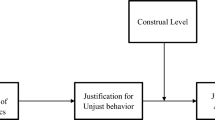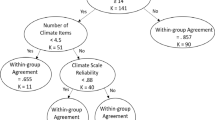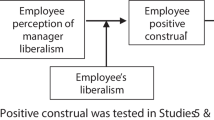Abstract
Rooted in the theory of planned behavior, our empirical reinvestigation of archived union certification election data provided strong evidence that workgroup solidarity was a significant predictor of individual voting behavior. Specifically, group-level attitudes toward unions accounted for individual voting behaviors beyond the individual-level attitudes toward unions. This study offers a meaningful increment to our knowledge as it provides a quantification of the extent that employees are willing to, and actually, comply with subjective norms. Important practical implications for both unions and employers as well as directions for future research are discussed.



Similar content being viewed by others
References
Ajzen I (1985) From intentions to actions: a theory of planned behavior. In: Kuhl J, Beckmann J (eds) Action-control: from cognition to behavior. Springer, Heidelberg, pp 11–39
Barling J, Kelloway EK, Bremermann EH (1991) Pre-employment predictors of union attitudes: the role of family socialization and work beliefs. J Appl Psychol 76(5):725–731
Barling J, Fullagar C, Kelloway EK (1992) The union and its members: a psychological approach. Oxford University Press, New York
Baumeister RF, Leary MR (1995) The need to belong: desire for interpersonal attachments as a fundamental human motivation. Psychol Bull 117(3):497–529
Bendix R (1956) Work and authority in industry. Wiley, New York
Blader SL (2007) What leads organizational members to collectivize? Injustice and identification as precursors of union certification. Organ Sci 18(1):108–126
Brief AP, Rude DE (1981) Voting in union certification elections: a conceptual analysis. Acad Manage Rev 6(2):261–267
Cooke WN (1983) Determinants of the outcomes of union certification elections. Ind Labor Relat Rev 36(3):402–414
Cotton CC, McKenna JF (1994) Gender and occupational level differences in union voting behavior. Human Relat 47(2):233–242
Deshpande SP (1992) A meta-analysis of some determinants of union voting intent. Relat Ind 47(2):334–341
Deshpande SP, Fiorito J (1989) Specific and general beliefs in union voting models. Acad Manage J 32(4):883–897
Dickens WT (1983) The effect of company campaigns on certification elections: law and reality once again. Ind Labor Relat Rev 36(4):560–575
Fiorito J (1987) Political instrumentality perceptions and desires for union representation. J Labor Res 8(3):271–289
Fishbein M, Ajzen I (1975) Belief, attitude, intention, and behavior: an introduction to theory and research. Addison-Wesley, Reading
Fornell C, Larcker DF (1981) Evaluation of structural equations models with unobservable variables and measurement error. J Mark Res 18:39–50
Getman JG, Goldberg SB, Herman J (1976) Union representation elections: law and reality. Russell Sage, New York
Hammer TH, Berman M (1981) The role of noneconomic factors in faculty union voting. J Appl Psychol 66(4):415–421
Hu L, Bentler PM (1999) Cutoff criteria for fit indexes in covariance structure analysis: conventional criteria versus new alternatives. Struct Equ Modeling 6(1):1–55
Mayo E (1933) The human problems of an industrialized civilization. Harvard Business School, Boston
Montgomery BR (1989) The influence of attitudes and normative pressures on voting decisions in a union certification election. Ind Labor Relat Rev 42(2):262–279
Podsakoff PM, MacKenzie SB, Lee JY, Podsakoff NP (2003) Common method biases in behavioral research: a critical review of the literature and recommended remedies. J Appl Psychol 88(5):879–903
Raudenbush SW, Bryk AS (2002) Hierarchical linear models: applications and data analysis methods, 2nd edn. Sage Publications, Thousand Oaks
Schriesheim CA (1978) Job satisfaction, attitudes toward unions, and voting in a union representation election. J Appl Psychol 63(5):548–552
Silverblatt R, Amann RJ (1991) Race, ethnicity, union attitudes, and voting predilections. Ind Relat 30(2):271–285
Summers TP, Betton JH, Decotiis TA (1986) Voting for and against unions: a decision model. Acad Manage Rev 11(3):643–655
Youngblood SA, DeNisi AS, Molleston JL, Mobley WH (1984) The impact of work environment, instrumentality beliefs, perceived labor union image, and subjective norms on union voting intentions. Acad Manage J 27(3):576–590
Zalesny MD (1985) Comparison of economic and noneconomic factors in predicting faculty vote preference in a union representation election. J Appl Psychol 70(2):243–256
Author information
Authors and Affiliations
Corresponding author
Additional information
The authors wish to thank Gilad Chen, Daniel G. Gallagher, and the anonymous reviewers for their helpful comments.
Rights and permissions
About this article
Cite this article
Martinez, A.D., Fiorito, J. & Ferris, G.R. Solidarity Revisited: Group-level Effects on Individual-level Union Voting. J Labor Res 32, 61–74 (2011). https://doi.org/10.1007/s12122-011-9102-0
Published:
Issue Date:
DOI: https://doi.org/10.1007/s12122-011-9102-0




